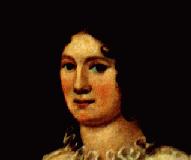Claire Clairmont
|
|
Clara Mary Jane Clairmont (April 27, 1798 – March 19, 1879), or Claire Clairmont as she was commonly known, was a stepsister of writer Mary Shelley. She was one of two children of Mary Jane Vial Clairmont and Charles Gaulis Clairmont. It is suspected that Claire’s parents were never married and that her mother had adopted the name Clairmont to disguise the fact that her children were illegitimate.
In December of 1801, Mary Jane Clairmont married William Godwin. Godwin had a daughter, Mary, who just was eight months older than Claire. The two girls would grow to be close and remain in contact with one another throughout the duration of their lives.
Claire is most noted for seducing Lord Byron before he left England in 1816 to live abroad. She was just eighteen and Byron made it very clear to her before he left that she would not be a part of his life. Claire, on the other hand, was determined she would change his mind. She convinced Mary and her husband-to-be, Percy Bysshe Shelley, that they should follow Byron to Switzerland, where they met him and Dr Polidori at the Villa Diodati by Lake Geneva. It is unknown whether or not Claire knew she was pregnant with Byron's child at the commencement of the trip, but it soon became apparent to both her traveling companions and to Byron not long after their arrival at his door. He maintained his refusal of Claire's companionship and only allowed her to be in his presence in the company of the Shelleys.
The group left Byron in Switzerland at the end of the summer and returned to England. Claire took up residence in Bath and in January of 1817 she gave birth to a daughter, Allegra. The following year, Claire and the Shelleys left England and journeyed once more to Byron, who now resided in Italy. Claire felt that the future Byron could provide for their daughter would be greater than any she herself would be able to grant the child and, therefore, wished to deliver Allegra into his care.
Upon arriving in Italy, Claire was again refused by Byron. He arranged to have Allegra delivered to his house in Venice and agreed to raise the child on the condition that Claire keep her distance from him. Claire reluctantly gave Allegra over to Byron.
Byron entertained the infant for a short period of time and then placed her in a convent. Claire was outraged. His seemingly callous treatment of the child was further vilified when Allegra died there from typhus at the age of five. Claire held Byron entirely responsible for the loss of their daughter and hated him for the rest of her life. Percy Bysshe Shelley's death followed only two months later. Devastated, Mary returned to England. She paid for Claire to travel to her brother's home in Vienna where she stayed for a year before relocating to Russia to work as a governess. She returned to England in 1828, but remained there only a short while before departing for Dresden, where she was again employed as a governess.
Claire settled in Paris in the 1840s and traveled often to England. She moved to Florence in 1870 and died there on March 19, 1879, at the age of eighty-one. In her later years she is described as having become very strange. She converted to Catholicism, though she had previously detested the Catholic Church. She even expressed doubts that her daughter had actually died.
Claire also clung to memorabilia of Percy Bysshe Shelley. The Aspern Papers by Henry James is based on the author's attempts to gain ownership of these items. Claire, however, would not part with her keepsakes.

